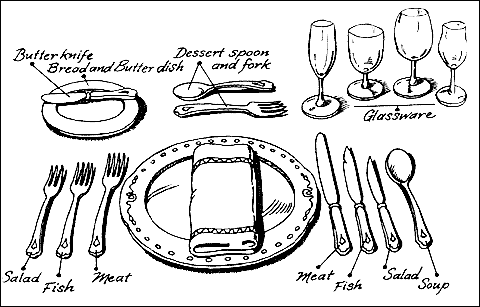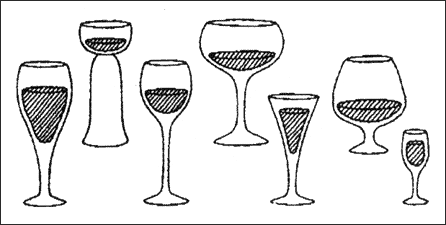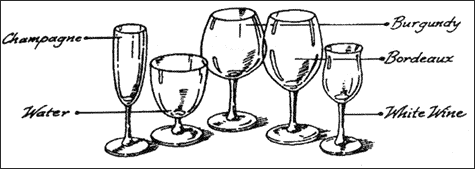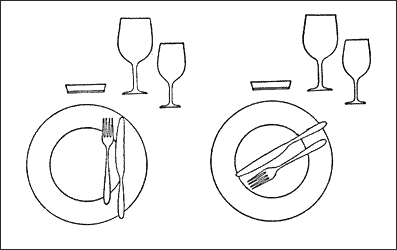Etiquette and Table Manners
Dinner Etiquette
Positioning of a Place Setting for Dinner
 Place Plate-The place plate is placed one inch from the edge of the table. If the first course is already on the place plate, the napkin is placed to the left of the forks, otherwise the napkin will be on the plate.
Place Plate-The place plate is placed one inch from the edge of the table. If the first course is already on the place plate, the napkin is placed to the left of the forks, otherwise the napkin will be on the plate.
Forks/Flatware-Handles of the flatware are aligned at the bottom.
The forks (no more than three) are at the left of the place plate, placed in order of use, working from the outside in. The oyster fork is the only fork on the right side with the knives, tines of the fork placed upward, across the soup spoon or parallel with the knives.
Often in North America the salad is served prior to the main course. In this case, the salad fork is positioned the furthest from the plate on the left. One would use this fork first. In the case of French style dining, the salad would be served after the main course. In this case, the salad fork would be positioned next to the plate.
Knives-Knives, no more than three, are at the right of the place plate in order of use, from the outside in, with the cutting edge toward the plate. The only spoon (for a first course) is placed to the right of the knives.
Dessert Silverware-The dessert fork and spoon are above the place plate, the bowl of the spoon facing left, the fork below facing right. In the most formal setting, the dessert fork and spoon are brought in on the dessert plate.
Glassware–No more than four glasses are set on the table, in order of use, for water, white wine, red wine and champagne, from the left to the right.
Full Glasses-When filling glasses, note the diagram. Don’t overfill!

Stemware-Note the shapes of each type of stemware. They all have a unique shape and should only be used for their respective drinks.

Bread and Butter Dish-The butter plate (optional) has the knife placed across the top of the plate, handle to the right, edge of blade toward the user. The salt and pepper are above the place plate, pepper to the left of salt. Larger salts and peppers to be shared are placed slightly below the wine glasses and between every two place settings.
At the end of the meal, you should place your used silverware close together on the plate, with the utensils entirely on the plate (less than an inch of the silverware over the side of the plate). This is a signal to the servers that your meal is finished and the dishes may be removed.

For a formal dessert service, a waiter brings each guest a finger bowl filled with water. The bowl is set on a small lace or organdy doily (optional), which in turn sits on the dessert plate. The dessert fork and spoon are balanced on the plate in this case (instead of sitting at the top of the place setting throughout the meal.) A guest should dip finger tips in the finger bowl, wipe them on his or her napkin, and then remove the finger bowl and doily to the upper left of the place setting. He or she now moves the fork and spoon from the plate to the left and right of the plate respectively. The empty plate is now ready to receive a helping of dessert.
Proper Eating Style

Yes No
The correct way to cut your meat, whether eating American or continental style, is to grasp your knife and fork in a relaxed, natural manner, never with clenched fists. Elbows are never placed on the table, they are accepted only when everyone has finished the meal.

American style Continental style
- In the American style of eating, after cutting your meat, you switch the fork to your right hand, place your knife on the plate, spear a piece of meat, and then eat it. The idle hand may be left hidden on your lap.
- In the Continental eating style, you keep your fork in your left hand and convey the food to your mouth after cutting each piece. The knife remains in your hand and may be subtly used to get meat or any other food. The hands should never be hidden under the table for any length of time.
- Do not cut all the meat at once, cut only one or two small pieces ahead of time.
- Each time after using your napkin, place soiled section inside the folded portion so one cannot see it.
More Etiquette at a Dinner Function
- Dress for the occasion. “Formal” or “Black Tie” means tuxedos and ball gowns. Business lunch or dinner usually means you should wear a suit or other professional attire.
- At business functions, arrive 5 to10 minutes early (not more) if not otherwise specified. Check your appearance. If it is a private home dinner party, always arrive on time or just a few minutes late (5 to 10 minutes), never early or much later.
- Greet your host(s). Shaking hands is the usual way, particularly if it is a business function. Shake hands with a firm but not too hard a squeeze as someone wearing rings will feel pain if you squeeze too hard and the rings will leave marks on their fingers. A limp handshake or with finger tips only is not a good handshake, get a solid grip and shake as though you mean it…. If you are wearing a coat, ask where you can put it.
- If there is a cocktail party first, limit your intake, especially if you have to drive.
- Be sure to leave your right hand free for shaking hands or eating. You can do this by using all the fingers and palm of your left hand. Fold your napkin loosely around your little finger. Balance the hors d’oeuvre plate between your ring and middle fingers, and hold your glass or cup between your index finger and thumb. It takes a little practice.
- Wait to go in to dinner or sit down until either your host(s) say to sit or until they are seated. Leave your jacket on until dessert comes unless you are so hot you can’t stand it, then place it around the back of your chair.
- Put your napkin on your lap. If it is a large one, fold the top half down. After wiping your mouth, place the soiled section of your napkin inside the folded section so that the soiled parts do not show.
- If you are ordering from a restaurant menu, avoid asking for changes to the item, or the most expensive meal option, or food that will drip, slip or be messy (ie: Lobster to crack, unless you are not the only one ordering it).
- If you are ordering wine, the simple thing is to ask the host or waiter to recommend something. White wine is recommended for fish, chicken, and vegetables; red for red meat and heavy dishes like lasagna. Beer works with hot food. If you are there as part of an interview, do not drink more than one glass.
- Whoever orders the wine will have a small amount poured into the glass to taste. Take your time, smell it delicately, sip it, rolling it around on your tongue, then swallow. Unless it tastes like “vinegar” or it is “corky”, nod your head and say something like, “Excellent!” or “Very Good.”
- It is best to hold your glass by the stem, especially with cool white wine and champagne, as cupping the glass with your hand will warm up the wine/champagne very fast.
- It is okay to order a drink that does not contain alcohol.
- Use your eating utensils from the outside in. If you are unsure about anything,
watch your host or others around you. Use them delicately so you avoid a lot of noise as they touch the plate. - Pass to your right. If someone asks for the salt, pass both salt and pepper.
- Your beverages should be on the right of your plate and food like bread and salad on your left. This will help you avoid eating or drinking someone else’s food.
- If soup is served, remember to spoon away from you. Also tip the bowl away from you. This helps stop the drips. Leave the spoon turned over in the bowl when you are finished.
- Hold your knife in your palm with three fingers around it, the index finger on the top, and your thumb on the inside of it. Hold it gently and use pressure from your index finger and thumb to cut.
- Never, never lick your knife.
- After you have cut a piece of food, in North America, you may put your knife down on your plate with the blade to the inside and switch your fork to your other hand to eat. Yes, it is weird and the Europeans do not do it this way, but we do.
- Don’t reach across anyone for something on the table; always ask the person nearest to it or to you to pass it.
- When butter is being passed, cut a pat and place it on your bread plate.
- Tear off a small piece of bread to butter. Never butter the whole slice. Lay your butter knife down with the blade to the inside.
- Use your knife or a piece of bread to help corral the pesky vegetables, never use your finger(s) to push food unto your fork.
- Talk to everyone around you, but don’t yell at someone down the table. Of course, don’t talk when your mouth is full either.
- Don’t place your elbows on the table; in fact, unless you are cutting something that requires both hands, your idle hand should be in your lap (or in Continental Style, your idle hand should be on the table).
- If coffee is served, it usually comes with a teaspoon you can use to add sugar or stir.
- If you have dessert or fruit, the dessert fork or spoon will either be above your plate, or will be served with the dessert.
- Use the restroom to pick food out of your teeth or repair your makeup. If you have to excuse yourself from the table, place your napkin on your chair. Women, if you are in a very high-class restaurant, you might find an attendant in the restroom. You are supposed to tip that person if she provides any service to you.
- When you are finished eating, place your knife and fork side by side in the middle of the plate with the handles resting on the plate. Fork tines should be turned down and the knife blade turned in. Place the napkin to the right side of your plate or on your chair when you get
up. - The host(s) should pick up the restaurant tab, so don’t offer. But it never hurts to have money or a card handy just in case. Thank your host(s) for a wonderful meal (unless you ended up paying for it).
